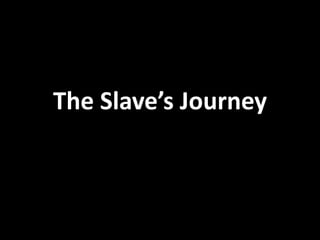
Slavery Images
- 2. While Viewing: • Write down observational notes • Write down questions • Write down words that describe the images
- 10. The Door of No Return
- 18. Slave Auction, Easton, Maryland
- 23. La Amistad La Amistad (Spanish: Friendship) was a 19th-century two-masted schooner built in Spain and owned by a Spaniard living in Cuba. While it was transporting Mende captives originally kidnapped in Sierra Leone from Havana, Cuba, in July 1839, the Africans took control of the ship. La Amistad was captured off the coast of Long Island by the Revenue Cutter USS Washington. The Mende and La Amistad were interned while court proceedings were undertaken for their disposition. The case, United States v. The Amistad (1841) was finally decided by the Supreme Court of the United States in favor of the Mende, restoring their freedom. It became a symbol in the movement to abolish slavery.
- 24. After Viewing: • Write a brief reflection about what you’ve seen. How do you feel? What value, if any, can be gained from viewing these images? What questions do you have?
Hinweis der Redaktion
- Captioned, "Slavers Revenging their Losses," shows a coffle of men, women, and children, led by Arab slavers; one of the guards is murdering a captive unable to keep up with the rest. These people were taken across Central Africa to the east coast of Africa. The engravings in this book are based on, according to the editor," rude sketches" made by Livingstone. On June 19, 1866, Livingstone wrote: "We passed a woman tied by the neck to a tree and dead, the people of the country explained that she had been unable to keep up with the other slaves in a gang, and her master had determined that she should not become the property of anyone else if she recovered after resting a time. . . . we saw others tied up in a similar manner . . . the Arab who owned these victims was enraged at losing his money by the slaves becoming unable to march, and vented his spleen by murdering them" (p. 56). This is one of the best known and frequently reproduced images in the literature on slaving in Africa.
- nterior courtyard, where captive Africans were assembled, and "Gate of No Return," the passageway through which they were led to the beach and from there to slaving vessels waiting offshore. (Photographed by Michael Tuite in Ghana; Aug. 1999)